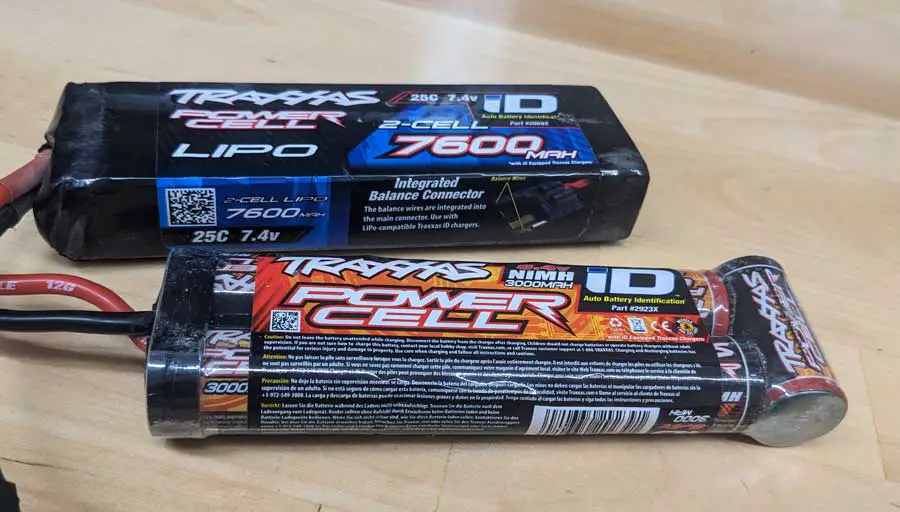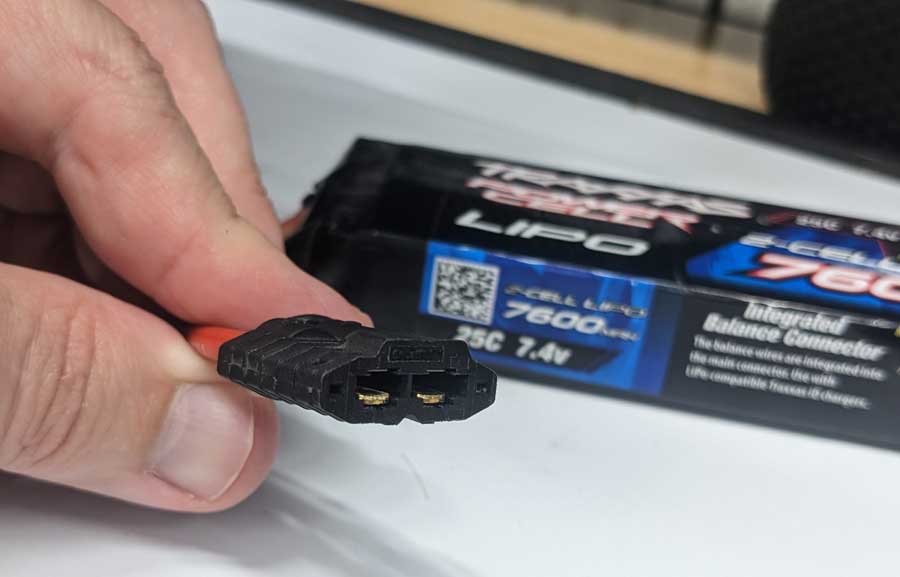There’s nothing worse than getting ready to spend an afternoon running your RC car and finding out that your batteries won’t hold a charge.
As much as I like my Traxxas RC cars, there have been a few times when their batteries simply wouldn’t charge.
Sometimes it was an easy fix, and other times, it wasn’t.
Here are nine reasons why your Traxxas RC batteries won’t charge correctly.
Battery Issues
I’ve split this list into two main sections: battery issues and charger problems.
This section will look at why a problem with the Traxxas battery itself is why it won’t charge.
Dead Battery
A dead battery is one of the most common reasons a Traxxas RC car battery will not charge. This usually occurs when the battery has been left discharged for an extended period or has not been balanced correctly (for LiPo batteries).
When a battery is completely drained, it can cause the cells within the battery to become damaged or even die, preventing it from holding a charge in the future.
To avoid a dead battery, be sure to maintain the battery by charging it regularly so it’s not completely discharged.
Traxxas recommends charging the battery as soon as possible after use and storing it at a partial charge when not in use.
Similarly, avoid running the battery down to a low voltage, as this can cause permanent damage to the battery and significantly reduce its lifespan.
Many electronic speed controllers (ESC) have low voltage protection that kicks in when it detects unsafe voltage levels in LiPo batteries. However,
it’s less common to find this level of protection for NiMH batteries.
If you suspect that your battery is dead, there are some steps you can take to try and revive it. Try charging it longer than usual or using a specialized battery charger designed to restore dead batteries.
However, if the battery is completely dead, it may need to be replaced to get your Traxxas RC car up and running again.

Overheated Battery
When an RC car’s battery becomes too hot, it can cause irreversible damage to the battery’s cells and internal components. This leads to reduced battery capacity, performance and a shorter lifespan overall.
Most people think that overheating occurs only during use but can also happen during charging.
This can be caused by various factors, including overuse, high ambient temperatures, or improper charging procedures.
As a result, the battery may expand or swell and start smoking or catch on fire in extreme cases.
It’s essential to follow all recommended charging procedures and to avoid charging the battery at excessively high temperatures To prevent overheating and damage to your Traxxas RC car battery.
Additionally, monitoring the battery’s temperature during use and charging is crucial. Immediately stop using or charging the battery if it becomes too hot.
If your Traxxas battery has become damaged due to overheating, DO NOT USE IT. Contact Traxxas customer support or the battery manufacturer for specific instructions.
In some cases, a damaged battery may be repairable or may be covered under warranty. In other cases, you may need to replace it to prevent damaging your RC car.
Defective Battery
You may have a defective battery if it cannot hold a charge, has a short lifespan, or is not working at all. Faulty batteries can be caused by various factors, including manufacturing defects, damage during shipping or storage, or physical damage to the battery itself.
To help determine if your battery is defective, check its voltage and internal resistance. When a battery’s voltage is too low or the internal resistance is too high, it may indicate the battery is defective.
Physical damage, such as cracks or leaks, can also be signs of a defective battery.
If you suspect your battery is defective, contact the manufacturer immediately. Depending on the circumstances, you may be able to get a replacement battery under warranty or through a return policy.
Battery Memory Effect
Battery memory is a phenomenon that can occur in certain types of rechargeable batteries, including LiPo (lithium polymer) and NiMH (nickel-metal hydride) batteries.
It occurs when a battery is not fully discharged and recharged regularly, causing it to “remember” its previous state of charge and reducing its overall capacity over time.
In the case of LiPo batteries, memory effect is not a significant concern. They are less prone to developing memory than other battery types. However, they still require special care and handling to prevent damage, including proper charging and storage procedures.
For NiMH batteries, the memory effect is a bigger issue.
When NiMH batteries are not fully discharged and recharged regularly, they can develop a memory of the lower charge level, setting this as its new ‘maximum charge.’
n effect, this causes the battery to lose capacity and performance over time.
To prevent memory effects in NiMH batteries, it’s essential to fully discharge and recharge them regularly.
Also, avoid storing the battery for extended periods without use. This allows the cells to reset and reduces the likelihood of memory buildup.
Damaged Battery Contacts
Battery contacts transmit power between the battery and the charger.
If these contacts become bent, corroded, or otherwise damaged, they may not contact the charger correctly. This can prevent the battery from charging.
Bent or damaged contacts can be caused by various factors, including improper handling, storage, or battery use. Additionally, exposure to moisture, dirt, or other contaminants can cause corrosion or damage to the contacts over time.
If you suspect you have damaged battery contacts, inspect the contacts for any visible signs of damage or wear. Look for corrosion or rust, as well as bent or warped contacts. If the connections are severely damaged, they may need to be replaced, which typically means replacing the entire battery.

For minimal damage, clean the contacts using a soft cloth or brush to remove any dirt or debris interfering with the charger. Always ensure the connections are clean and dry before attempting to charge the battery again.
Avoid placing excessive stress on the battery contacts. This can cause damage over time.
It’s a good idea to periodically inspect the contacts for any signs of wear or damage, replacing them when necessary.
Aging Battery
As any rechargeable battery ages, it gradually loses its ability to hold a charge, eventually becoming unusable.
This is due to a combination of factors, including the natural degradation of the battery’s cells over time, exposure to high temperatures, or prolonged periods of inactivity.
Over time, you’ll notice the battery’s capacity and overall performance gradually decline. This results in shorter run times and decreased power output.
The battery may become prone to overheating or other issues in rare cases.
To get the most life out of your Traxxas battery, follow all recommended charging and storage procedures. LiPo batteries have specific charging and storage procedures to get the most life out of them as possible.
No matter what type of battery you have, avoid exposing the battery to excessive heat or other environmental factors that can accelerate degradation.
Charger Issues
Occasionally, the reason why your Traxxas battery won’t charge has nothing to do with the battery. Charger issues are less common, but they can still ruin your day.
Loose Connections
We’ve all been there. We thought we’d plugged in the charger correctly, only to return later to find nothing had happened.
Loose or corroded connections between the battery and charger can also prevent proper Traxxas RC car battery charging.
When the connections inside the charger become loose or corroded, the battery may not be able to properly transmit power to the charger. This often results in slow or incomplete charging.
Note: Always unplug your battery charger before cleaning or troubleshooting!
To fix loose connections, it’s important to first disconnect the battery from the charger and inspect the connections. Check for any visible signs of corrosion or damage. Clean the contacts using a soft cloth or brush if necessary. Ensure the connections are secure and tight before attempting to charge the battery again.
Corrosion can be caused by various factors but is usually caused by exposure to moisture or environmental factors, such as salt or chemicals.
Always store your battery and charger in a dry, cool place to avoid exposing them to moisture or other corrosive elements.

Faulty Charger
A faulty charger is another common reason a Traxxas RC car battery won’t charge. If the charger is not working correctly, it may be unable to properly charge the battery or even damage it.
Common causes of faulty chargers include damaged cables, blown fuses, or malfunctioning internal components.
To troubleshoot a faulty charger, start by checking the connections between the charger and the battery. Ensure the charger is properly plugged in and the battery is securely connected to the charger. Additionally, check the charger’s cables and components for any signs of damage or wear.
Test the charger with different batteries and on other electrical outlets.
If the charger is still not working correctly, you may need to replace it with a new one. When purchasing a new charger, it’s essential to ensure that it is compatible with your Traxxas RC car battery and that it is from a reputable manufacturer.
Incorrect Charger
Although less common, using the wrong charger is another reason a Traxxas RC car battery may not charge.
Different types of batteries require different kinds of chargers. Using the wrong charger can damage the battery or prevent proper charging altogether.
To avoid using the wrong charger, determine the type of battery your Traxxas RC car uses.
Check the battery’s voltage and capacity and any other specifications listed on the battery or in the owner’s manual. Once you know the battery’s specifications, you can choose a charger designed specifically for that type of battery.
It goes without saying, but choose a charger from a reputable manufacturer and follow all recommended charging procedures to ensure proper charging and avoid damage to the battery.
If you are unsure which charger to use, contact Traxxas customer support or the battery manufacturer for guidance.
Wrapping It Up
In conclusion, there are a variety of reasons why a Traxxas RC car battery may not charge properly, including issues with the charger, damaged or corroded contacts, overheating, and aging.
It’s important to troubleshoot each of these potential issues to determine the root cause and take appropriate steps to address it.
If you’re experiencing issues with your Traxxas RC car battery not charging, check the charger and ensure it’s properly connected and functioning. Next, inspect the battery contacts for any signs of damage or wear, and clean them if necessary.
If the battery is overheating, stop using it immediately and allow it to cool down before attempting to charge it again.
If you cannot resolve the issue on your own, consider contacting Traxxas customer support or the battery manufacturer for assistance. Sometimes, the battery may need to be replaced to ensure optimal performance and safety.
Overall, by following recommended charging and storage procedures and addressing any issues promptly, you can help extend the lifespan of your Traxxas RC car battery and ensure reliable and consistent performance over time.
